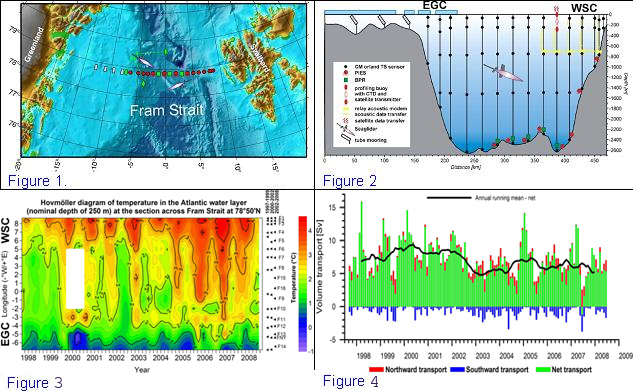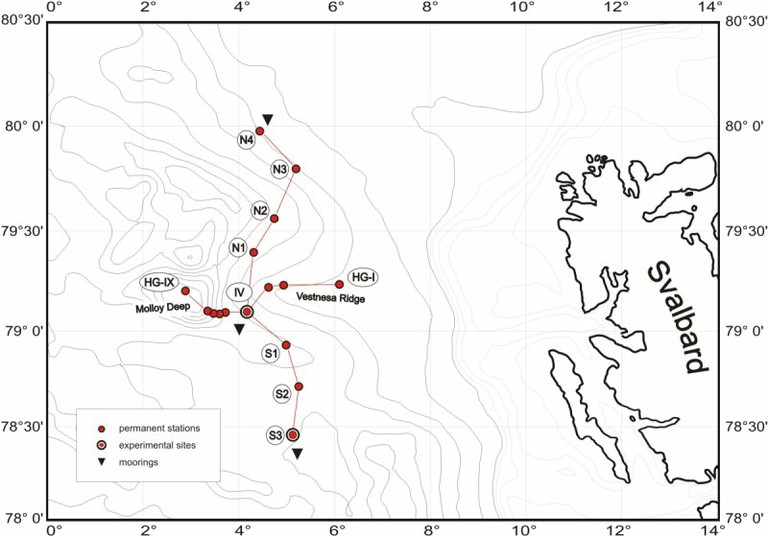AWI will contribute to Arctic ROOS by the following activities:
(1) Water mass properties measurements in the central Greenland Sea at 75°N
AWI surveys the convective state of the Greenland Sea with high resolution repeat sections along 75°N and 3 profiling CTD moorings in the central Greenland Sea.

Fig.0, Variability of temperature and salinity in the Atlantic Water inflow through the eastern Greenland Sea to the Arctic Ocean (left panel) and in the Return Atlantic Water flowing southward at the western rim of the Greenland Sea (right panel) measured at summer hydrographic sections along 75°N.
(2) Measurements of transports through Fram Strait
The magnitude and variability of the fluxes through Fram Strait is an important element in understanding and monitoring climate variability in the Arctic as well in the Nordic Seas. AWI and NPI operate a set of moorings along approximately 79°N equipped with current meters, some of them are equipped with ULSs, since 1997. Hydrographic sections across Fram Strait approximately are carried out annually either by NPI or AWI. The array will be adjusted in order to be sustainable by reducing the number of moorings according to the results obtained by NERSC’s tomography array by focussing on the boundary currents and applying sea gliders in the interior of the strait. Acoustic data transmission to a surface relay station in order to obtain quasi-real-time data is in field trials.
Web address to the site where products are presented:

Fig. 1: Locations of the mooring array maintained by AWI and NPI in Fram Strait. The use of gliders under sea ice is still in a planning stage and the sound sources for acoustic navigation are not jet deployed.
Fig. 2: Moorings in Fram Strait maintained by AWI and NPI. The operation of gliders and acoustic links are on trial in the DAMOCLES and ACOBAR EU projects and will lead to a reduction of the number of moorings.
Fig. 3: Increase of temperature in the level of the Atlantic Water inflow in the Arctic Ocean observed by moorings the Fram Strait from 1997 to 2006.
Fig. 4: Monthly averages and annual running mean of the volume transport in the West Spitsbergen Current measured at the moored array in 1997-2008.
(3) The deep-sea long-term observatory Hausgarten
To detect and track the impact of large-scale environmental changes in a the transition zone between the northern North Atlantic and the central Arctic Ocean, the Alfred Wegener Institute for Polar and Marine Research established the deep-sea long-term observatory HAUSGARTEN. The observatory displays 16 permanent sampling sites along a depth transect (1000-5500 m) and along a latitudinal transect following the 2500 m isobath (Fig. 1). Repeated sampling and the deployment of moorings and different free-falling systems which act as observation platforms has taken place since the beginning of the station in summer 1999. HAUSGARTEN represents a key site of the European Network of Excellence ESONET (European Seas Observatory Network).
Contact: T. Soltwedel (Thomas.Soltwedel@awi.de), M. Klages (Michael.Klages@awi.de)
Project information:
Soltwedel et al. (2005). HAUSGARTEN: multidisciplinary investigations at a deep-sea, long-term observatory in the Arctic Ocean. Oceanography, 18(3), 46-61.
pdf available:
http://www.tos.org/oceanography/issues/issue_archive/issue_pdfs/18_3/18.3_soltwedel_et_al.pdf
Project Website:
Publications featuring results from investigations at HAUSGARTEN:

Fig. 4: The deep-sea long-term observatory Hausgarten in the eastern Fram Strait.
See also: Temperature, salinity and volume fluxes in the Fram Strait




















